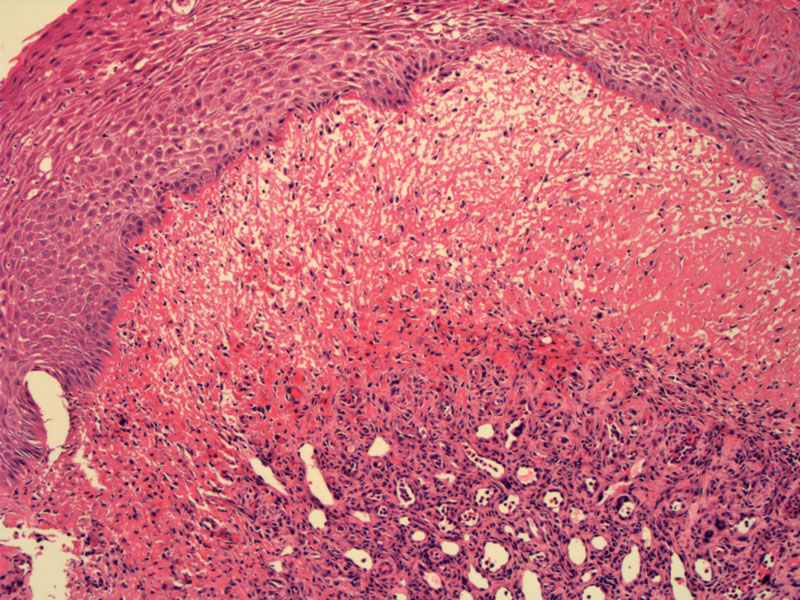

A vascular-type polyp consists of normal squamous mucous (top), edematous stroma (middle) and underlying granulation tissue with proliferation vessels (bottom).
Dense sclerosis with surrounding scattered lymphocytes comprise this polyp, with overlying reactive irregular squamous epithelium.
Other areas of the sclerotic polyp show ulceration and bacterial colonies and replacement by fibrin.
A third case shows uniformly dense eosinophilic stroma with variable but hypocellular stroma. Reactive keratosis overlies the squamous epithelium.
Vocal cord nodules and polyps are different clinical entities, although their histology is often identical. Vocal cord nodules are more commonly found in young women and in people who routinely stress their vocal cords (singers, auctioneers, hecklers). On the other hand, vocal cord polyps are found in all age groups and contributing factors include smoking, infection and hypothyroidism.1
Grossly, vocal cord nodules tend to be bilateral, edemematous, gelatinous or hemorrhagic masses several millimeters in diameter. Vocal cord polyps tend to be unilateral, larger rubbery masses that may reach several centimeters in size.
Microscopically, vocal cord nodules and polyps are similar and may exhibit a range of histologies depending on the age of the polyp/nodule. The masses are initially edematous with a myxoid stroma, but will become fibrotic with time. Vascular proliferation may be seen with dilated vessels, granulation tissue and hemorrhage -- sometimes, the endothelial proliferation can be very florid and may be misdiagnosed as an angiosarcoma. Other features seen in polyps/nodules include a hyalinzed stroma with fibrin deposition; this eosinophilic material was initially thought to be amyloid, however, this material does not stain with Congo red.1,2
The overlying squamous epithelium is usually normal, however, it may be hyperkeratotic metaplasic, atrophic or hyperplastic (probably as a response to irritation). The stroma may contain hemosiderin deposits; inflammation is generally sparse.
In general terms, vocal cord nodules are more common in young women and vocal cord polyps are more common in smokers. Hoarseness and voice changes are often the presenting clinical symptoms.
Small nodules may be treated with voice rest; larger polyps and nodules will need surgical excision. The underlying factors (smoking, hypothyroidism, infection) should be addressed.
1 Thomspon LDR. Endocrine Pathology: Foundations in Diagnostic Pathology. Philadelphia, PA: Elsevier; 2006: 9-13
2 Mills, S. Histology for Pathologists. 3rd Ed. Philadelphia, PA: Lippincott, Williams & Wilkins; 2007: 361-2.